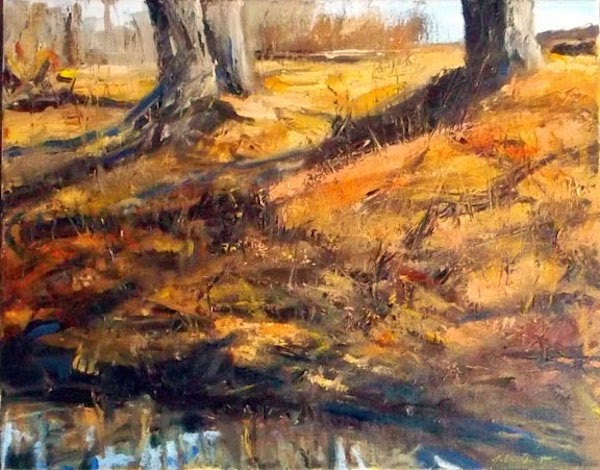
Painting with a palette knife is a challenging, but rewarding approach to paint application.
When applied, the colors make an immediate impact due to their purity. However, the palette knife can be a difficult tool to master because the initial application of paint is so direct and striking.
There is a purity of color that can be achieved when painting with a knife that is very different than with a brush. The “creaminess” of the paint really shows, and the intensity of the color is strong, which is partly due to its layering on the paint surface.
Palette Knife Painting Tips:
- Try the tapered palette knife, which is strong yet flexible. It allows you to mix the paint thoroughly before applying.

- Squeeze out the colors that you want to mix. For example, Ultramarine Blue and Titanium White, and knead them with the knife until completely mixed. There is no better way to mix colors.
- The newly mixed color can then be applied at will. Load-up one flat edge of the knife and spread out the color to fill an entire area.
- The larger the knife, the more area coverage.
- The palette knife is also useful for details and expressive marks, like a tree trunk or branch.

The ultimate benefit of painting with a knife is the ease from which you can change colors. When painting outside in plein air, the drudgery of cleaning a brush in order to use a different color is aggravating, and the brush never gets fully clean. Since I am outside and often working quickly, I don’t like to use too many brushes that would need to be juggled (and inevitably, dropped).
The palette knife is simply wiped clean for each color with a good thick rag. This allows more time to be spent on the painting and less on the preparation.
Guest artist/author: Jonathan Van Brunt has been painting with a palette knife since his days at the Maine College of Art in 1984. You can see more of his works on his blog, Van Brunt Art.
*****
You can find more great tips on Fine Art Tips Facebook Fan Page, on Twitter, Google Plus and on Pinterest. Be sure and check out and my fine art prints and notecards on Fine Art America.








Thanks for the tips, Jonathan. I’ve wanted to paint with palette knife for quite some time, especially as I’m reading Richard Schmid’s Alla Prima II and see the beautiful purity of colors achieved with palette knife application in his flowers.
And you made a great point about the benefits of palette knife when it comes to plein air painting. I should definitely try it. Now I’m going to Youtube it a bit because I’ve never painted with a knife before. Thanks again.
Thanks for reading. Richard Schmid’s work is a good place to look. Also, if you’d like to see some “extreme” knife painting look at Lynn Boggess’ work. (http://www.lynnboggess.com/). Really nice stuff!
Hello Jonathan, thanks for the added tips here. I will check out Lynn’s work. Happy painting!
Jonathan, I love the palette knife. When I wanted to learn how to use it, I asked a palette knife user and she said, “You have to put the brush a way for a year.” I did that and it makes a huge difference. I can now easily go back and forth between the brush and the knife.
Try applying paint to just the edge of the knife and you can get all kinds of organic looking lines. Enjoy!
@Lucy Chen If you want to learn the different oil painting techniques using pallete knife. Have a look at this link http://www.jerrysartarama.com/art-lessons/Artists/Dick-Ensing/Dick-Ensing-How-to-Use-a-Palette-Knife-in-Oil-Painting.html @Lori These are some pretty good tips for beginners. Nice post!
Thanks for passing this link onto us! Glad you enjoyed this post Levi 🙂
We tried palette knife to create designs like bark and grass.
Hello Dave, I use the knife for those details also. I keep learning how to improve with palette knife techniques and enjoy mixing it with brushwork…
Using a pallete knife does seem quite daunting, but you’ve shown how striking and bold the results can be. I love the organic feel. Thanks for the tips! I’ll try and keep away from paintbrushes!
Yes Milly, the palette knife really helps break up the mechanical brushstrokes that many artists create. I like mixing the knife and brush for interesting passages. Thanks and good luck!
Do you use Gesso or a painting medium on the blank canvass before you begin painting? I cannot find the answer anywhere. Thanks for this. Great site.
Hello Coleen, I am way behind on comments. I hope you found the answer by now. Gesso is the ground we paint upon. Yes, I use it under my acrylic and oil paintings. It helps the canvas support the painting. The oil needs gesso as a base coat. I hope this helps.